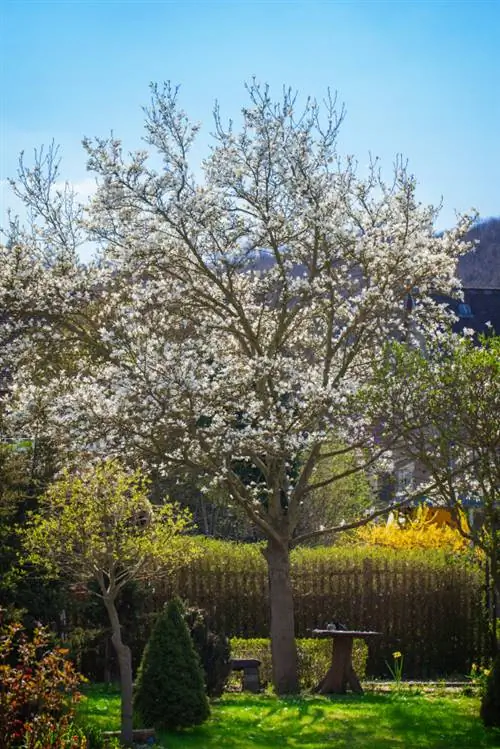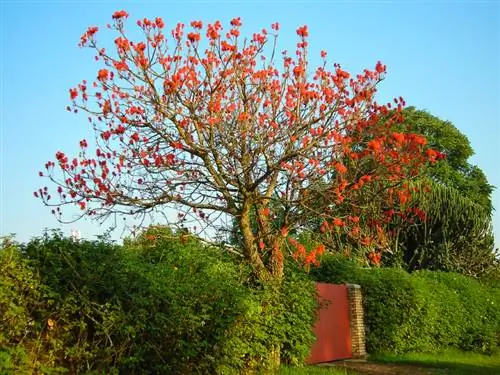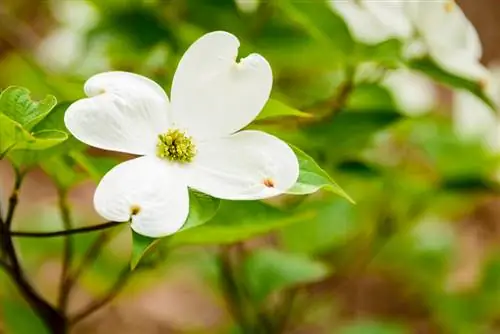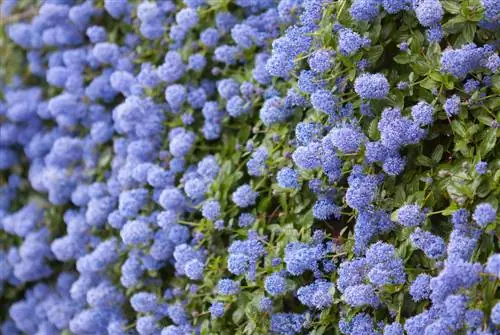- Author admin [email protected].
- Public 2023-12-16 16:46.
- Last modified 2025-06-01 06:02.
Ash maple is colorful in the summer garden with colorfully variegated feather leaves. In March, delicate hanging flowers herald spring. Densely bushy and sprawling, with elegantly hanging branches, Acer negundo is a hit for creative garden design. Compact premium varieties are recommended as magnificent trees for the hobby garden. It's worth taking a look at the profile and cultivation. Read everything you need to know about ash maple and its ornamental value in hobby gardens here. This is how you plant and care for Acer negundo correctly.

What characterizes the ash maple in the garden?
The ash maple (Acer negundo) is a 5 to 15 m tall large shrub or tree that impresses in the summer garden with colorful, variegated pinnate leaves and hanging flowers in March. Low-growing varieties such as Flamingo, Aureo-Variegatum or Variegatum are suitable for the hobby garden.
Profile
- Scientific name: Acer negundo
- Occurrence: Central Europe, North America
- Growth type: large shrub, tree
- Growth height: 5 to 15 m
- Growth habit: multi-stemmed, spreading
- Wood: color inclusions, fine-pored, elastic
- Flowers: hanging, grape-like
- Leaf: pinnately pinnate
- Fruit: winged
- Root: deep roots with runners
- Winter hardiness: hardy
- Use: house tree, privacy screen, hedge
Wood
Ash maple wood surprises with beautiful colors, is easy and excellent to work with. Wood is highly valued in high-quality furniture construction and fine interior design. Cabinet makers, wood turners, sculptors and carvers rave about the multi-faceted processing options. Precious furniture, valuable inlays, exquisite parquet floors, artistic table tops and sonorous musical instruments gain decorative expressiveness thanks to the fine wood with the remarkable grain:
- Consistency: fine-pored, elastic, pressure and tensile strength, low shrinkage
- Sapwood: yellow, white and green color inclusions
- Heartwood: yellowish-brown to reddish-pink grained
Bloom
Ash maple is one of the dioecious, separate-sex plants. The trees bear female or male flowers. The hanging inflorescences appear in March before the leaves emerge. The following table summarizes how you can distinguish between female and male flowers based on their optical characteristics:
| Ash Maple Blossom | Female Flower | Male flower |
|---|---|---|
| Shape | Grape | panicle |
| color | yellowish-green-white | yellowish-green to reddish |
| Speciality | long, hanging, grape-like | thin, hanging, tufty |
Admire the extravagant flowers that adorn an ash maple in early spring in the following video:
Video: Ash maple in its pompous blossoms
Leaf
The ash maple's most beautiful decoration is its summer-green, opposite, pinnate leaves on elegantly overhanging branches. You can accurately identify the leaf of an Acer negundo by the following characteristics:
- Leaf size: 15 to 20 cm long, 10 to 15 cm wide
- Leaf shape: imparipinnate with 3 to 5 serrate or lobed leaflets
- Feathers: 5 to 10 cm long, thinly hairy, oval, pointed, light green, lighter underneath
- Feather seat: lower pair of feathers on a 1 to 2 cm long stem, upper pair of feathers without a stem
Excursus
Heroically standing strong in floods
If the landscape is under water, most maple species demonstrate heroic endurance. If you struggle with a high groundwater level and permanently waterlogged clay soil in your garden, an ash maple won't let you down. Even after prolonged flooding, the robust trees do not lose their stability and beauty.
Planting ash maple - tips
Ash Maple makes no secret of his desire to conquer. From a deep taproot, epically long lateral roots sprout in all directions. As soon as it has been planted, the majestic tree kicks into high gear with a growth rate of 100 to 150 centimeters per year. More suitable for the hobby garden are weak-growing varieties that remain at a height of 500 to 700 centimeters and grow relatively slowly at 15 to 30 centimeters annually. However, you should not forego planting with a root barrier. How to plant Acer negundo correctly:
Location
Ash maple proves its reputation as a valued pioneer tree with its good-natured adaptability. This is what the perfect location should be like:
- Sunny to semi-shady location
- Ideally protected from the wind
- Preferably fresh, moist, nutrient-rich soil with a slightly acidic pH value of 5 to 6
Ash maple can cope with calcareous, moist or dry, sandy and poor garden soil.
Planting time
The best time to plant ash maple from the nursery is in autumn. The time window remains open until next spring to plant the tree in containers, with wire bales or as root crops.
Soil preparation
Your new house tree will thank you for careful soil preparation with rapid rooting and uniform growth. Furthermore, the probability of failure is reduced to a minimum if you take these precautions at the site before planting:
- Dig garden soil two spades deep, remove old roots, stones and weeds
- Improve sandy-lean soil with compost soil (3 to 5 l/m²)
- Loose up wet, heavy soil with sand, lava granules, expanded clay or lava mulch
Plants
To plant a 100 to 150 cm tall ash maple from the nursery, please provide the following tools: spade, folding ladder, sledgehammer, 3 sharpened, 2.50 m long wooden posts (€5.00 on Amazon), coconut rope and gloves. How to plant correctly:
- Dig a planting pit with twice the volume of the root ball
- Line the pit with a rhizome barrier
- Mix the excavated material with horn shavings and compost
- Remove the container, leave the bale cloth on the bale
- Place the tree in the middle of the planting hole (open the bale cloth)
- Plant ash maple straight and securely in the enriched soil
Before slurrying, drive the support posts 50 centimeters deep into the ground at a distance of 30 centimeters from the trunk or central shoot. Connect the posts and trees with the coconut rope to protect against wind.
Ash maple - care tips
In the simple care program, two measures have priority. If the tree becomes too sprawling, pruning it will solve the problem. Regular watering protects ash maple trees from drought stress when they are young. The initial fertilization recommended here as part of planting is not followed by any further nutrient supply. How to care for ash maple in an exemplary manner:
Cutting
A strong sap flow characterizes the growth of ash maple and its varieties almost all year round. In late autumn and early winter the sap pressure decreases slightly. By the traditional February date for pruning trees and bushes, the trees are already in full sap. The timing is just as important as the incision. This is what you should pay attention to when pruning Acer negundo:
- Rule of thumb: only cut ash maple when necessary
- Cutting date: beginning of December to mid/end of January
- Preparation: Sharpen and disinfect cutting tools, protect skin and clothing from the sticky juice
- Pruning guide: remove excessively long branches and do not simply cut them, avoid cuts in the old wood, thin out dead wood on branches
Pouring
In the first six to eight weeks after planting, please visit the ash maple tree every two days with the watering can. Until the roots become established in the soil, there is a risk of drought stress when the sun shines. Water generously with rainwater or stale tap water. In the first few years there is always a need for watering when the soil surface feels dry.
Wintering
After a service life of around five years, an ash maple is reliably hardy down to -30° Celsius. We recommend light winter protection on the way there. Cover the root slice with leaves and brushwood. During the planting year, a breathable cover made of garden fleece protects the young shoots from frost damage.
Popular varieties
In the tree nursery you can discover picturesque varieties with variegated foliage and a garden-suitable height of 500 to 700 centimeters:
- Ash maple 'Flamingo': leaflets marbled white-green, flamingo-pink shoots on the red petiole.
- White Ash Maple: Synonym for premium variety 'Flamingo'.
- Yellow ash maple 'Aureo-Variegatum': Leaves irregularly variegated in bright golden yellow in a sunny location.
- Silver ash maple 'Variegatum': historical variety, leaves with silvery-white edges, green-white marbled.
- Acer negundo 'Elegans': dark green pinnate leaves, light green edged and spotted.
- Yellow ash maple 'Odessanum': golden yellow pinnate leaves, tinged with light green in summer.
FAQ
How to eliminate an ash maple tree?
With a trunk diameter of up to 30 cm, you can cut down an ash maple and dig up the roots. Ringing has traditionally proven to be effective for removing invasive trees. Remove a 10 to 15 centimeter wide strip of bark and cambium wood from the lower trunk area. The sap flow is interrupted and the tree dies within 12 to 36 months.
Is pruning beneficial for branching?
In fact, pruning young wood promotes branching and promotes dense, bushy growth. The best time is on a frost-free day in December or January. Use disinfected, sharp bypass scissors. Place the scissor blades a few millimeters above a bud. Holding the pruning shears slightly at an angle allows the tree sap to drain more easily. Please remember to protect yourself from the sticky maple sap with gloves and appropriate clothing.
At what distance from the house should you plant ash maple 'Flamingo'?
Considering a growth height of up to 7 meters and a width of up to 6 meters, we recommend a planting distance of at least 3 meters. If the distance to the house is shorter, you can keep the large shrub smaller by pruning it regularly. Planting with a root barrier also makes sense.
At what temperature does young ash maple need winter protection?
In the planting year and in the first two to three years, we recommend winter protection for young ash maple at temperatures from -5° Celsius. A layer of leaves on the root disc and a garden fleece as a hood are completely sufficient. Please keep the protective fleece handy in the spring when the weather forecast predicts nighttime ground frosts, which can be fatal to the newly planted buds.
The leaves on the recently planted ash maple 'Flamingo' are curling. What to do?
The tree suffers from drought stress. Water the shrub thoroughly without causing waterlogging. In the future, keep the soil constantly slightly moist. Check several times a week using a thumb test to see whether the soil feels dry. Experience has shown that after two years an ash maple tree is so deeply rooted that normal rainfall covers its water requirements.






